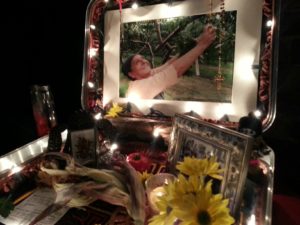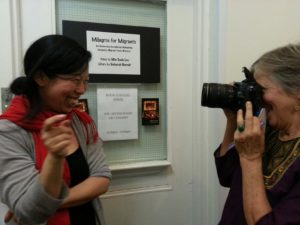Min Sook Lee describes the multimedia installation she helped to curate, Milagros for Migrants, as “an organic meeting of two artistic practices.” We’re having lunch at Oakham House Cafe on the campus of Ryerson University, where the exhibit is housed. To her left sits her artistic collaborator and academic advisor, Deborah Barndt. While we wait for salads, Barndt tells me that they have worked together in the past on similar projects, and have overlapping interests when it comes to academia and activism.
“We have a common passion for art and politics and thinking about how art can be used to educate and organize around migrant worker justice. I’ve done a lot of work around labour in the food system over the years,” she says.
“It all just dovetailed really easily,” Lee adds from behind the screen of her Mac.
Lee tells me that she works primarily as a documentarian. She is currently filming a documentary about migrant women in Ontario. Her contribution to the installation features clips from her film played continuously on a projection screen.
“My part of the show is an excerpt of stuff I’ve been shooting. It’s a seven minute piece I edited together. When people walk in this video piece will play for them,” Lee explains, showing me footage from the film on her laptop.
The installation comes in two parts: the video projection and the altars. The idea is that visitors tour the installation space and view the altars while the film is playing. The altars are in-situ and contain symbols representing the migrant experience: photographs, specialized prayer cards, vegetables, voice recordings, and of course, milagros.
Milagros are small tokens commonly left at altars in prayer or gratitude in Mexico and Latin America. The altars themselves are made of opened suitcases. Together, Barndt and Lee have created what they call an immersive installation in honour of migrant workers in Ontario. The installation is being hosted as part of this year’s Mayworks Festival of Working People and the Arts.
When she tells me about the altars, Barndt says that she felt inspired to act by the tragic car accident that took the lives of ten Peruvian migrant workers last year. She wants to honour those killed and those who continue to labour in similar circumstances.
“I felt like it was one of those moments when suddenly the public, which might not have had any consciousness even that there were migrant workers in the fields picking our fruits and vegetables, was becoming more aware of it. It’s only when you have these kinds of tragedies that then the media pays attention and you’ve got actually the possibility of educating people about these sort of deeper questions,” she explains.
Lee nods fervently.
I ask what she means, and she says that much of her research deals with the internal contradictions of the local food movement. She tells me that even though local food is picked by global labour, by migrants, issues of labour justice rarely enter into the conversation when it comes to local food.
“In the last several years I’ve been really involved in the local food movement and trying to open up the question of the contradiction of migrant labour. The fact is that local food is picked by global labour and a lot of that is not addressed within the movement, even though there is a kind of social justice discourse [present],” she says.
Barndt recalls a conference she organized at Ryerson around food labour justice last year. “We tried to bring together labour activists and food activists. I was particularly interested because I am part of both fields but they’re not talking to each other. There is a real animosity and so part of my interest is in how you can start those conversations across sectors,” she said.
Leaning forward professorially, she tells me that we can take the analysis a step further. “[It’s] not just the fact that local food might be picked by global labour, but also [trying] to understand why do they come in the first place? What is it in the global context that pushes Mexican workers off the land to come to Canada and leave their families behind? [And] in order to support their families. I’m really interested as an educator in how you use those moments,” she adds.
(Min Sook Lee and Deborah Barndt)
Lee thinks we’re in one of those moments now around the temporary foreign worker program. Canadians are paying attention because the Royal Bank of Canada has come under fire recently for laying off Canadian workers and hiring cheap foreign labour through the temporary worker program instead. Of course, the program was not designed to replace Canadian workers. The program is being used as a crutch to relieve an artificial labour shortage. The shortage is the direct result of employers lacking incentive to create an attractive workplace for Canadian workers. Instead, employers are seeking out foreign labour because migrant workers are often willing to take precarious jobs for relatively low pay.
“This is a manufactured labour crisis because there are no labour rights being respected […] employers are not providing safe workplaces and they are not paying a decent wage,” she says.
Lee is critical of the way that the media is framing the issue. She says that mainstream media is not talking enough about the fact that temporary foreign workers are legally paid fifteen percent less than Canadian workers for the same jobs. Or talking about the fact that migrant workers take on jobs that others don’t want. These are jobs that involve the “three d’s” because they are either dirty, difficult, or dangerous. Often, migrant labourers cannot speak up about workplace violations for fear of losing their jobs.
She worries that the concerns currently being raised by the media around laying off Canadian workers, which are valid, leave little room for discussing the human rights concerns the migrant justice movement has raised when it comes to the labour market.
“The media attention has largely been focused around that [issue] and most of it has not looked at how the program is intrinsically exploitative and that it is being used to bring in and create a second tier labour economy with workers from poorer nations,” she says.
Lee tells me that she and Barndt want to create an intentional encounter between Canadians and the migrant workers that live alongside them, picking their food or supplying them with other essential services. For all that migrant workers do, they still enjoy limited visibility. Milagros for Migrants aims to counter mainstream media narratives around migrant labour and highlight the sacrifices that foreign labourers make daily. The hope is that this will generate solidarity between migrants and Canadian workers.
“It’s a big issue. A big picture. And this exhibit is intended to start a conversation and to take the momentum of organizing that’s been going on in our country around the issue and to build that further. In my lifetime I’ve seen an incredible social movement rise up around migrant worker justice. Even when you compare to fifteen years ago, there was nothing like what we see now. This [installation] is part of putting art into that conversation,” Lee says.
Muna Mire is a student in her final year at the University of Toronto where she is completing an Honours B.A. in English, Political Science and Sociology. At U of T, she serves as Editor-in-Chief for The Strand, Victoria University’s student newspaper. She is formerly Rabble’s podcast network intern and currently freelances there. Her interests include pop culture and progressive politics.
This article was originally published by the Canadian Media Guild and is reprinted here with permission.
Milagros for Migrants installation has been at Ryerson University this week, closing tonight.




